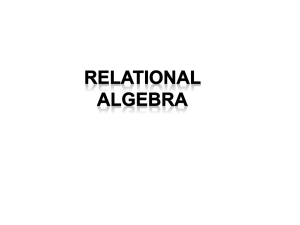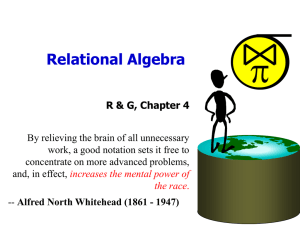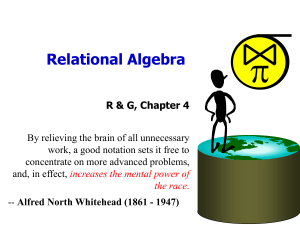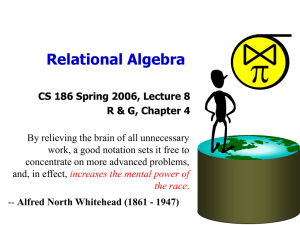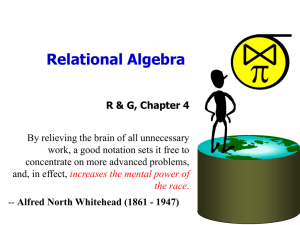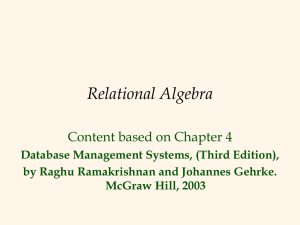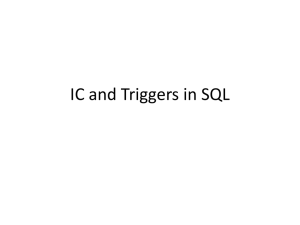Algebra
advertisement
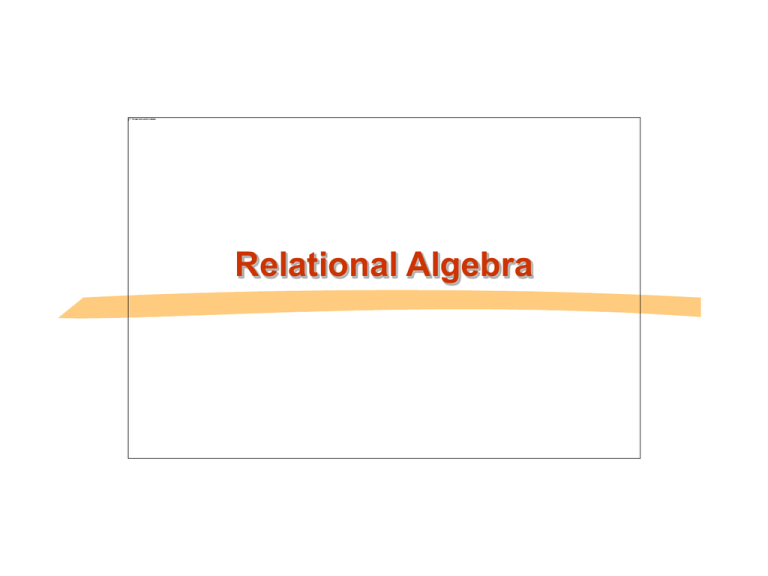
Relational Algebra Relational Query Languages Query = “retrieval program” Language examples: Theoretical: 1. Relational Algebra 2. Relational Calculus a. tuple relational calculus (TRC) b. domain relational calculus (DRC) Practical 1. SQL (SEQUEL from System R) 2. QUEL (Ingres) 3. Datalog (Prolog-like) Theoretical QL’s: give semantics to practical QL’s key to understand query optimization in relational DBMSs Relational Algebra Basic operators select ( ) project (p ) union ( ) set difference ( - ) cartesian product ( x ) rename ( ) The operators take one or two relations as inputs and give a new relation as a result. relation relation relational operator relation Example Instances bid 101 102 103 104 bname Interlake Interlake Clipper Marine color blue red green red Boats Schema: Boats(bid, bname, color) Sailors(sid, sname, rating, age) Reserves( sid, bid, day) R1 sid 22 58 bid 101 103 day 10/10/96 11/12/96 sid S1 22 31 58 sname dustin lubber rusty rating 7 8 10 age 45.0 55.5 35.0 sid S2 28 31 44 58 sname yuppy lubber guppy rusty rating 9 8 5 10 age 35.0 55.5 35.0 35.0 Projection Examples: p age(S2) ; p sname,rating(S2) Retains only attributes that are in the “projection list”. Schema of result: exactly the collumns in the projection list, with the same names that they had in the input relation. Projection operator has to eliminate duplicates (How do they arise? Why remove them?) Note: real systems typically don’t do duplicate elimination unless the user explicitly asks for it. (Why not?) Projection sid 28 31 44 58 sname rating age yuppy 9 35.0 lubber 8 55.5 guppy 5 35.0 rusty 10 35.0 S2 sname rating yuppy lubber guppy rusty 9 8 5 10 p sname,rating (S 2) age 35.0 55.5 p age(S2) Selection () Selects rows that satisfy selection condition. Result is a relation. Schema of result is same as that of the input relation. Do we need to do duplicate elimination? sid 28 31 44 58 sname rating age yuppy 9 35.0 lubber 8 55.5 guppy 5 35.0 rusty 10 35.0 rating 8(S2) sname yuppy rusty rating 9 10 p sname,rating( rating 8(S2)) Selection Notation: p(r) p is called the selection predicate , r can be the name of a table, or another query Predicate: 1. Simple attr1 = attr2 Attr = constant value (also, <, > , etc) 2. Complex predicate1 AND predicate2 predicate1 OR predicate2 NOT (predicate) Union and Set-Difference All of these operations take two input relations, which must be union-compatible: Same number of columns (attributes). `Corresponding’ collumns have the same type. For which, if any, is duplicate elimination required? Union sid 22 31 58 sname rating age dustin 7 45.0 lubber 8 55.5 rusty 10 35.0 S1 sid 28 31 44 58 sname rating age yuppy 9 35.0 lubber 8 55.5 guppy 5 35.0 rusty 10 35.0 S2 sid sname rating age 22 31 58 44 28 dustin lubber rusty guppy yuppy 7 8 10 5 9 S1S2 45.0 55.5 35.0 35.0 35.0 Set Difference sid 22 31 58 sname rating age dustin 7 45.0 lubber 8 55.5 rusty 10 35.0 sid sname rating age 22 dustin 7 45.0 S1 S2 S1 sid 28 31 44 58 sname rating age yuppy 9 35.0 lubber 8 55.5 guppy 5 35.0 rusty 10 35.0 S2 sid sname rating age 28 yuppy 9 35.0 44 guppy 5 35.0 S2 – S1 Cartesian-Product S1 R1: Each row of S1 paired with each row of R1. Like the c.p for mathematical relations: every tuple of S1 “appended” to every tuple of R1 Q: How many rows in the result? Result schema has one field per field of S1 and R1, with field names `inherited’ if possible. May have a naming conflict: Both S1 and R1 have a field with the same name. In this case, can use the renaming operator… Cartesian Product Example sid 22 31 58 sname dustin lubber rusty rating 7 8 10 age 45.0 55.5 35.0 sid bid day 22 101 10/10/96 58 103 11/12/96 R1 S1 (sid) sname rating age S1 X R1 = (sid) bid day 22 dustin 7 45.0 22 101 10/10/96 22 dustin 7 45.0 58 103 11/12/96 31 lubber 8 55.5 22 101 10/10/96 31 lubber 8 55.5 58 103 11/12/96 58 rusty 10 35.0 22 101 10/10/96 58 rusty 10 35.0 58 103 11/12/96 Rename ( ) Allows us to refer to a relation by more than one name and to rename conflicting names Example: (X, E) returns the expression E under the name X If a relational-algebra expression E has arity n, then (X(1->A1, 2->A2, …, n->An), E) returns the result of expression E under the name X, and with the attributes renamed to A1, A2, …., An. Ex. (C(1->sid1, 5->sid2), S1xR1) Compound Operator: Intersection In addition to the 6 basic operators, there are several additional “Compound Operators” These add no computational power to the language, but are useful shorthands. Can be expressed solely with the basic ops. Intersection takes two input relations, which must be union-compatible. Q: How to express it using basic operators? R S = R (R S) Intersection sid 22 31 58 sname rating age dustin 7 45.0 lubber 8 55.5 rusty 10 35.0 S1 sid 28 31 44 58 sname rating age yuppy 9 35.0 lubber 8 55.5 guppy 5 35.0 rusty 10 35.0 S2 sid sname rating age 31 lubber 8 55.5 58 rusty 10 35.0 S1 S2 Compound Operator: Join Joins are compound operators involving cross product, selection, and (sometimes) projection. Most common type of join is a “natural join” (often just called “join”). R S conceptually is: Compute R S Select rows where attributes that appear in both relations have equal values Project all unique atttributes and one copy of each of the common ones. Note: Usually done much more efficiently than this. Useful for putting “normalized” relations back together. Natural Join Example sid 22 58 bid 101 103 day 10/10/96 11/12/96 sid 22 31 58 sname rating age dustin 7 45.0 lubber 8 55.5 rusty 10 35.0 R1 S1 S1 R1 = sid 22 58 sname dustin rusty rating 7 10 age 45.0 35.0 bid 101 103 day 10/10/96 11/12/96 Other Types of Joins Condition Join (or “theta-join”): R c S c (R S) (sid) 22 31 sname dustin lubber rating 7 8 S1 age 45.0 55.5 (sid) 58 58 S1.sid R1.sid bid 103 103 day 11/12/96 11/12/96 R1 Result schema same as that of cross-product. May have fewer tuples than cross-product. Equi-join: special case: condition c contains only conjunction of equalities. Compound Operator: Division Useful for expressing “for all” queries like: Find sids of sailors who have reserved all boats. For A/B attributes of B are subset of attrs of A. May need to “project” to make this happen. E.g., let A have 2 fields, x and y; B have only field y: AB x y B( x, y A) A/B contains all tuples (x) such that for every y tuple in B, there is an xy tuple in A. Examples of Division A/B sno s1 s1 s1 s1 s2 s2 s3 s4 s4 pno p1 p2 p3 p4 p1 p2 p2 p2 p4 A pno p2 pno p2 p4 B2 pno p1 p2 p4 sno s1 s2 s3 s4 sno s1 s4 A/B1 A/B2 sno s1 B1 B3 A/B3 Expressing A/B Using Basic Operators Division is not essential op; just a useful shorthand. (Also true of joins, but joins are so common that systems implement joins specially.) Idea: For A/B, compute all x values that are not `disqualified’ by some y value in B. x value is disqualified if by attaching y value from B, we obtain an xy tuple that is not in A. Disqualified x values: A/B: p x ( A) p x((p x( A)B) A) Disqualified x values sid 22 58 Example Instances bid 101 102 103 104 bname Interlake Interlake Clipper Marine Schema: Boats(bid, bname, color) Sailors(sid, sname, rating, age) Reserves( sid, bid, day) day 10/10/96 11/12/96 Reserves color blue red green red Boats bid 101 103 sid 28 31 44 58 sname yuppy lubber guppy rusty Sailors rating 9 8 5 10 age 35.0 55.5 35.0 35.0 Examples of RA Queries Find the names of sailors who have reserved boat 103 Find the name of sailors who reserved a red boat Find the color of boats reserved by Lubber Find names of sailors who have reserved a red or a green boat Find names of sailors who have reserved a red and a green boat Examples of RA Queries Find the names of sailors who reserved at least two boats Find the sids of sailors with age over 20 who have not reserved a red boat Find the names of sailors who reserved all boats
